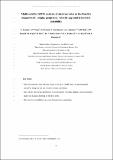Multisatellite MMS Analysis of Electron Holes in the Earth's Magnetotail: Origin, Properties, Velocity Gap, and Transverse Instability
Author(s)
Lotekar, A.; Vasko, I. Y.; Mozer, F. S.; Hutchinson, Ian; Artemyev, A. V.; Bale, S. D.; Bonnell, J. W.; Ergun, R.; Giles, B.; Khotyaintsev, Yu. V.; Lindqvist, P.‐A.; Russell, C. T.; Strangeway, R.; ... Show more Show less
DownloadAccepted version (12.08Mb)
Open Access Policy
Open Access Policy
Creative Commons Attribution-Noncommercial-Share Alike
Terms of use
Metadata
Show full item recordAbstract
We present a statistical analysis of more than 2,400 electrostatic solitary waves interpreted as electron holes (EH) measured aboard at least three Magnetospheric Multiscale (MMS) spacecraft in the Earth's magnetotail. The velocities of EHs are estimated using the multispacecraft interferometry. The EH velocities in the plasma rest frame are in the range from just a few km/s, which is much smaller than ion thermal velocity VTi, up to 20,000 km/s, which is comparable to electron thermal velocity VTe. We argue that fast EHs with velocities larger than about 0.1VTe are produced by bump-on-tail instabilities, while slow EHs with velocities below about 0.05VTe can be produced by warm bistream and, probably, Buneman-type instabilities. We show that typically fast and slow EHs do not coexist, indicating that the instabilities producing EHs of different types operate independently. We have identified a gap in the distribution of EH velocities between VTi and 2VTi, which is considered to be the evidence for self-acceleration (Zhou & Hutchinson, 2018) or ion Landau damping of EHs. Parallel spatial scales and amplitudes of EHs are typically between λD and 10 λD and between 10−3 Te and 0.1 Te, respectively. We show that electrostatic potential amplitudes of EHs are below the threshold of the transverse instability and highly likely restricted by the nonlinear saturation criterion of electron streaming instabilities seeding electron hole formation: (Formula presented.), where ϖ = min(γ, 1.5 ωce), where γ is the increment of instabilities seeding EH formation, while ωce is electron cyclotron frequency. The implications of the presented results are discussed.
Date issued
2020-09Department
Massachusetts Institute of Technology. Department of Earth, Atmospheric, and Planetary SciencesJournal
Journal of Geophysical Research: Space Physics
Publisher
American Geophysical Union (AGU)
Citation
Lotekar, A. et al. "Multisatellite MMS analysis of electron holes in the Earth's magnetotail: Origin, properties, velocity gap, and transverse instability." Journal of Geophysical Research: Space Physics, 125, 9 (September 2020): e2020JA028066. © 2020 American Geophysical Union
Version: Author's final manuscript
ISSN
2169-9380
2169-9402